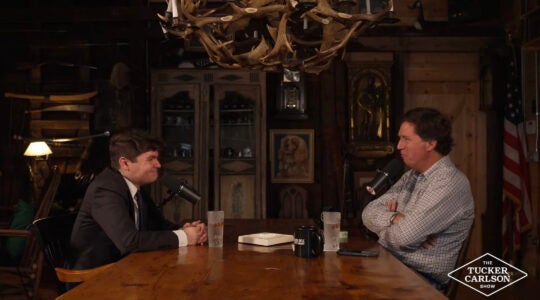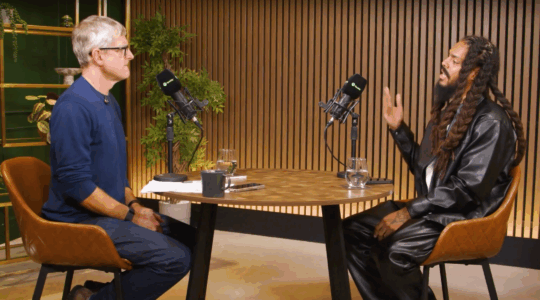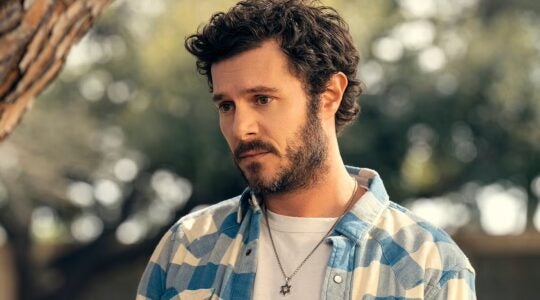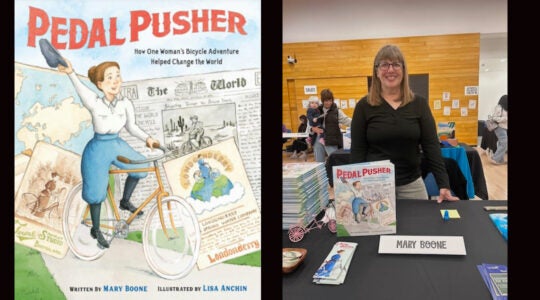AMSTERDAM (JTA) — At a Paris café after the war, a young publisher is quickly falling in love with an adorable Jewish author he just met as she discusses her still-unpublished book.
It is an intensely private account based on a personal diary that recounts her amazing survival of the Holocaust in hiding with her parents and sister in Amsterdam, in a small annex on Prinsengracht 263.
Her name is Anne Frank.
This scene is the bold introduction of the play “Anne,” which premiered at the Dutch capital’s new Theater Amsterdam on Thursday.
Produced with a multimillion dollar budget in an 1,100-seat theater built for this show, “Anne” is the first play ever written based on the full archive of the Frank family.
In reality, the Nazis caught the Franks after the family had spent more than two years in hiding. Anne died at the age of 15 at a German concentration camp along with her sister toward the end of World War II. Her mother perished at Auschwitz.
Yet in the world premiere of “Anne,” the ghost of the person she might have become is an omnipresent character who guides spectators through an elaborate plot that is distinguished from previous adaptations by its breadth: It begins before the Franks ever went into hiding and extends past her death from typhus at Bergen-Belsen.
The fantastical element of the fictional character of older Anne — the same Dutch actress, Rosa da Silva, juggles both Annes, sometimes in a single scene — is a singular artistic liberty in a play that otherwise adheres rigorously to historical accuracy.
“The principle of historical authenticity is one of the conditions we had for going ahead with this theatrical adaptation in the first place,” said Yves Kugelmann, a board member of the Anne Frank Fonds in Basel, Switzerland, who in 2009 initiated the writing of the new script and the Amsterdam production.
He noted that even the scene in Paris is based on entries from Anne Frank’s diary, in which she wrote that she dreamed of living in Paris.
The play is produced by Kees Abrahams and Robin de Levita, a Tony Award-winning Broadway producer who worked on hits such as “Chicago” and “Les Miserables.”
The show required a substantial initial investment by the for-profit Imagine Nation, founded by Abrahams and de Levita, and its sponsors. The company would not disclose the sum. The show is scheduled to play in additional locations in the future, according to Imagine Nation.
Imagine Nation pays the Anne Frank Fonds royalties from tickets that cost between $50 and $100. The foundation will use these revenues exclusively for charity and educational purposes, in keeping with Otto Frank’s directive.
To achieve authenticity, Kugelmann gave the creators of the play full access to countless documents that are the sole possession of the foundation. The foundation, was set up in 1963 by Otto Frank, Anne Frank’s father and the editor of the world-famous compilation of his daughter’s writings, “The Diary of a Young Girl,” first published in 1947.
Otto Frank had already approved a script by playwrights Frances Goodrich and Albert Hackett — an American Jewish couple — for a theatrical production that premiered on Broadway in 1955. But their adaptation was based on his own selection of sources, which left out countless documents, letters and other accounts.
Based on those more expansive materials, the new play tackles painful subjects, such as Anne’s growing estrangement from her mother and sister during their days in hiding. It also includes a scene in which she gets her first period.
“The theater world evolved in ways that facilitate the dramatization of situations which were more difficult to convey in the past,” Kugelmann said. “We wanted the play to evolve, too, but we wanted to broaden the scope and set the Anne Frank story in its historical Jewish context for educational purposes.”
The new play’s premiere, which was attended by King Willem-Alexander of the Netherlands, took place on the 69th anniversary of Nazi Germany’s surrender and shortly after the 70th anniversary of the death of Anne Frank and her sister, Margot.
The new techniques include a giant revolving platform that rotates the annex where the Frank family hid, allowing viewers a simultaneous view of all inhabitants. Kugelmann calls this “life-acted performance.”
The effect is reminiscent of reality television shows like “Big Brother” in which participants share a single building with little privacy.
And that is no coincidence.
“Anne Frank’s story was a ‘Big Brother’ show avant la lettre, one where exile meant death,” said Leon de Winter, the Dutch Jewish novelist who co-authored the script for “Anne” with his wife, Jessica Durlacher.
De Winter said he hoped the “Big Brother” allusion would help younger viewers connect to the play.
Another technical innovation offers spectators real-time footnotes to the scenes as they are being acted out on stage. The footnotes — photographs of actual pages full of Anne Frank’s handwriting — are projected on side panels while the cast portrays the situation described in the text.
As the months in hiding progress, the handwriting gradually matures from the hesitant block letters of a child to the flowing cursive style of an author who is gaining confidence as she hones her writing skills.
Authenticity is further pursued through language. The play itself is in Dutch with a bit of German. Simultaneous translation into six languages is offered to the audience through earpieces.
De Winter, whose parents survived the Holocaust in hiding, said that one of the predominant emotions he had while writing the script was anger.
“I worked with my anger, my fury, over what was done to her,” he said.
Durlacher, whose own father survived Auschwitz, said that she drew inspiration for the script from letters that Otto Frank had written to relatives after his return from the Nazi death camp.
“In the beginning, he didn’t know what had happened, he was only then finding out. And that’s heartbreaking,” she said, referring to Otto Frank. “It gave me the tools to write to my best ability so that the story of Anne Frank would get re-adapted for generations in a way which better speaks to contemporary viewers, in their language. That’s what we’ve tried to do.”
JTA has documented Jewish history in real-time for over a century. Keep our journalism strong by joining us in supporting independent, award-winning reporting.





